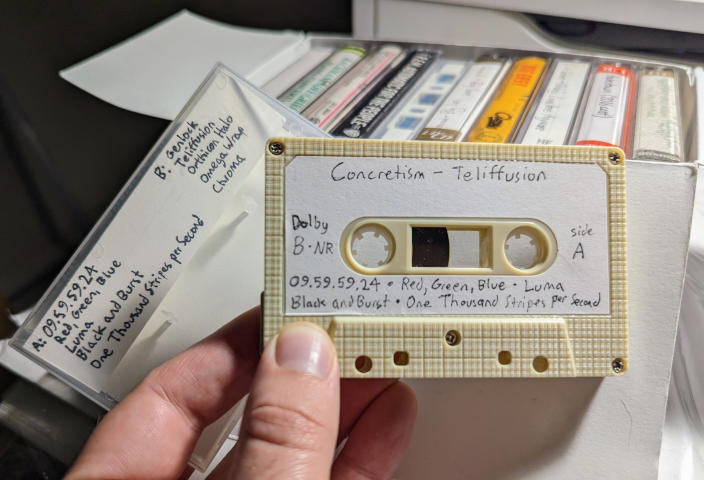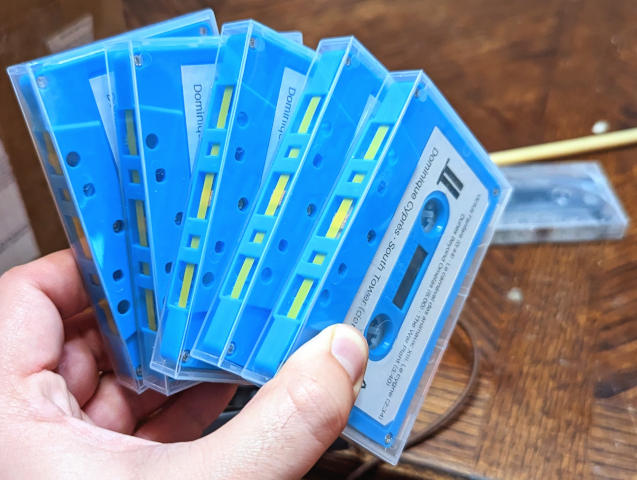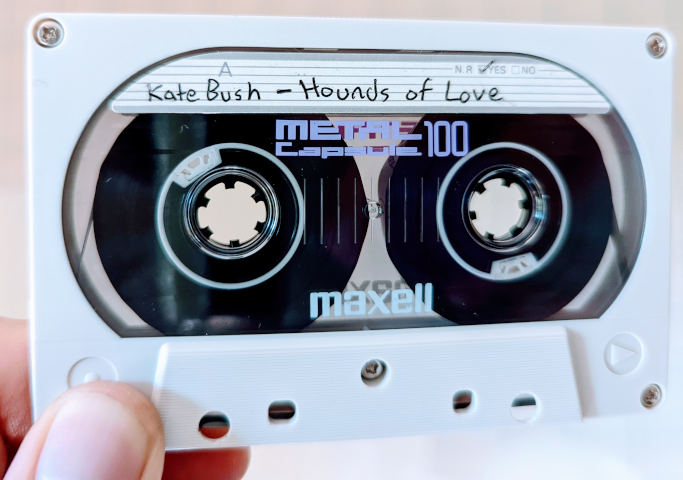Why cassettes?
Lately a lot of my interaction with music—listening, sharing, discovering, and making it—has been mediated through cassettes. So maybe I should explain why.
You know what we're talking about, of course: the Compact Cassette, that physical audio format developed by Philips in 1963, supporting four analog tracks magnetically encoded in the metal or metal oxide particles suspended in a long, ⅛”-wide strip of acetate spooled up inside a hard, standardized shell with spinning hubs and pullies to allow playback equipment to smoothly pull it across a little transducer at a constant rate of 1⅞ inches per second. If you grew up in my milieu, you probably just called them tapes.

They've had a little bit of a comeback lately. And that's been handy for me, because I was ready to reconnect with this format that was such a staple of my experience of music when I was a kid. But there's more than nostalgia to it for me. Listening to or sharing music on cassette offers some things I don't get from streaming digital platforms, and even some things I don't get from other other physical formats.
It's not about analog superiority
Let's just get this out of the way first: I don't listen to tapes because they sound “better” than digital. They don't.
Audiophiles might point out that analog audio sources can theoretically hold details you can't hear in digital. This is true because values in analog media are continuous. Over imperceptibly short periods of time, the numbers that represent different values on a sound wave in a digital recording jump instantaneously from one discrete value to another with no gentle slope between. Analog signals instead form smooth curves, so at some level they can contain tiny variations in slope that are too subtle for the digitization of that signal to represent.
The problem with analog superiority in general is that, when that digital signal is of standard CD quality (44,100 samples per second at 16-bit resolution), whatever details in the analog signal are too subtle to be captured digitally are also too subtle for me or really most people to hear.
Another issue more specific to cassettes is that, in practice, microscopic physical imperfections in the tape always introduce noise into the signal, which is much more audible than any details that would be lost to digitization and manifests as a constant hiss. This tape hiss could be much quieter than the recording on high-quality tapes in high-quality playback equipment, near-imperceptible even under just the right conditions, but it's always there, and various industry techniques exist for filtering it out as much as possible while leaving the recorded signal intact. The big reel-to-reel tapes that preceded cassettes and continued to be the standard for studio recordings for some time mitigated the hiss issue with much wider tape run at much higher speeds than cassette tape, to overwhelm those little physical imperfections through scale—usually ¼” wide at 15ips, but sometimes as wide as 2” and as fast as 30ips. When cassettes arrived with their narrower tape running at slower speeds, it was a compromise that sacrificed sound quality for portability and ease of use; it would take a few years for tape formulations to improve enough for mass market adoption of the cassette as a music format and not just a medium for voice dictation.
But in the end, digital will always have the advantage when it comes to resisting signal degradation and distinguishing signal from noise, for the same reason that it's easier to make out the dots and dashes of Morse code from a distant radio broadcast than it would be to identify spoken words under the same conditions: discrete, binary, off-or-on values are less ambiguous amidst noise.
The sound of home
Our gradually degrading analog audio media may not sound “better” than digital, but they do sound different, and for some they can sound different in a way that's preferable to digital perfection. My grandmother has often said that she would sometimes rather listen to her old vinyl records, or even digitizations of them, than to a perfectly remastered digital copy. The records, worn over time, their grooves filling with dust, have an added layer of noise when played back—pops, crackle, hiss, and skips—that are deviations from the original recording, imperfections, but nevertheless familiar imperfections that in many cases have become part of her memory of a song. When she listens to a remastered digital copy, it may be almost exactly what was originally recorded, but it is not quite the same song she has listened to on vinyl for all these years. Similarity, the imperfections of a cassette can personalize its sound for the listener, so that what they hear is not just a copy of the original recording, but their familiar, personal copy.
For some audio producers, deliberately creating or imitating these “lo-fi” imperfections can be a way to manufacturer a kind of stimulated nostalgia in a recording, or to add unpredictably and “character” to an otherwise “clean” or sterile sound. It's a common technique in some forms of hip-hop and electronic music.
The audio talisman
What I primarily get from cassettes is a qualitative, social-emotional experience of sound that I don't think I could entirely ever recreate with digital streaming. The way I relate to a recording when I carry it around physically in my pocket—not just my phone, which can provide access to that recording and many others, but a tape dedicated to containing just that recording and no other—just feels different. The tape becomes a little talisman that turns an intangible recording into a very tangible object, something I can see and turn over in my hands and physically give to another person. I would never suggest we all give up the technology of digital streaming, which is so much less limited in the recordings to which it can provide access, but the physical format offers a way to relate to and experience those recordings as physical objects in a way that streaming does not.
A commercially recorded cassette becomes a kind of touchstone to the time and place of its manufacture; for example my cassette copy of Switched-On Bach by Wendy Carlos may date back as far as the album's initial release in 1968. Its sound is somewhat rough, perhaps owing to the state of tape formulations at that time, and touching and listening to it makes me think of Columbia Records offices in the late '60s, when they were producing recordings of Wendy Carlos, Miles Davis, and Simon & Garfunkel, all of whom had to fight with the label for fair treatment in various ways.
A home-recorded cassette likewise becomes a touchstone to whoever recorded it, and the circumstances in which they did. Maybe it was a friend or relative hooking up their old phonograph to a cassette deck in a home they no longer inhabit. Maybe you recorded it yourself when you were a kid.

For me, this talismanic use of physical audio media as a portable physical manifestation of a recording is better served by the cassette than by similarly available formats like CDs or vinyl because I'm not afraid to handle cassettes. At times I've had to replace a pressure pad (basically just a little rectangle of felt on a spring barely inside the cassette, which gently holds the tape itself against the playback equipment's tape head, and which may disintegrate after a few decades), but overall it's a relatively resilient format; it doesn't scratch or shatter if I fumble it while carrying it around, and it doesn't have playable grooves to fill with dust or a shiny, exposed playing surface that collects smudges and fingerprints. It almost begs to be handled.
Physical specificity
The Compact Cassette standard allowed for s lot of variety. For one thing, there were three different widely-produced standards for tape formulation, which were indicated externally on consumer blank cassettes by the configuration of notches along the top edge: Type I (“normal bias”), Type II (“high bias”), and Type IV (“metal bias”). (There was also a short lived Type III variant that never caught on commercially, but it has the same notches as Type I). Within these types, manufacturers developed different proprietary take formulations that became known for different sonic properties. Some were better at recording bass frequencies; others had more accurate treble or a lower noise floor. And they had subtly different colors, ranging from light brown to dark gray or black.
Cassettes could also have slight mechanical variations. After all, the cassette is not an innert disk or strip of tape but a mechanical device with moving parts that the playback equipment uses to transport the tape itself, so some manufacturers would fine-tune the pulleys, liners, hubs, or bridge to improve stability and reduce friction.
But more fun than that are the aesthetic variations; the cassette shell could be any color at all, or any combination of colors, or clear and colorless, with pulleys and hubs of different colors inside. If the cassette wasn't fully transparent, a little rectangular window in the otherwise opaque shell could provide a view of how far the tape had progressed from one spool to the other, or a big oval window could do the same, or there could be no window at all. The surface could be matte, textured, or glossy and the corners sharp or rounded. Paper or vinyl labels could be applied, or various kinds of printing or etching could be done right on the cassette shell. And of course the packaging of the cassette could be infinitely more varied; though mass-market, commercially recorded cassettes in North America were mostly sold in standard-sized, hinges cases of rigid plastic with a clear front showing a J-card with album art and spine text and a clear or black back panel, novelty cassettes, underground releases, or mass-market releases in other markets such as Japan could be in any conceivable package from cardboard slipcases to vinyl clamshell boxes.

These specific physical attributes of a cassette enhance its talismanic quality, tying it more specifically to certain remembered experiences.
What makes a format eligible for a comeback?
Renewed consumer interest obviously fuels the revival of once-dominant media formats, but there is an important factor of market readiness as well. CDs are also having a sort of revival, and it helps that the supplies and equipment are ready to go because optical discs are still a preferred digital backup option for certain cases where cloud storage and USB devices are not considered adequate. The playback equipment for vinyl is relatively simple technology for small manufacturers in the boutique market to produce, and small vinyl presses have been kept going by a market of dedicated collectors and analog audiophiles that never went away, so vinyl is always ripe for a little resurgence.
Likewise, a lack of media and playback equipment can certainly hinder any kind of comeback. DAT, DCC, and MiniDisc all have a similar appeal to me as the Compact Cassette but are not as accessible or making as widespread a comeback.
Digital Audio Tape (DAT) was suppressed as a consumer format by the recording industry during its heyday, over concerns about the possibility of music listeners making unauthorized, perfect, digital copies of commercial recordings, so there is not all that much DAT equipment or media on the secondhand market. And any manufacturer that might want to make new DAT playback or recording equipment would need to use hard-to-source (and probably prohibitively expensive) helical scanners, which are much more complex than the tape head in a cassette deck and are more like a miniaturized version of the read component in a VCR.
Digital Compact Cassette (DCC) faces similar issues; its very short commercial life has left working equipment and media rare, and both the tape formulation and the tape heads require much more manufacturing precision than the Compact Cassette ever did.
MiniDisc is seeing a little comeback amongst some niche internet music labels, but since Sony discontinued the format, no small manufacturer has been up to the task of making either more media or new equipment. It's all very small and very precise magneto-optical components, and hasn't lived on as a backup solution like CD-sized optical disks. Additionally, unlike in Europe, where much of the MiniDisc resurgence occurs, here in North America MiniDisc never met with commercial success, owing to complicated market factors. This has left MiniDisc equipment and media harder to come by where I live.
Compact Cassettes avoid all of these problems because they and their equipment were so ubiquitous across most of the world for such a long time, and can be manufactured to relatively forgiving standards.
I just think they're neat
Ultimately, what I like about cassettes isn't that they're in any way an ideal or superior format. Sound quality and convenience are both better served by digital streaming. Thorny issues of digital ownership, archival, and “digital rights management” (DRM) are better addressed by CDs or maybe even DAT and digital backups.
The real reason that I prefer cassettes is, as Marge Simpson once said of potatoes: I just think they're neat. I hope I've explained some of what's neat about them.
Where not otherwise noted, the content of this blog is written by Dominique Cyprès and licensed under a Creative Commons Attribution-ShareAlike 4.0 International License.